What do you do next when you’ve been the top-rated Rock station in Seattle for years, based largely on creativity, talent, and out-of-the-box thinking?
Simple – you innovate. And late last year, Entercom’s KISW did just that, harping back to the days when radio stations had huge performance studios to accommodate live actors, booth announcers, entire orchestras, even sound effects teams (known as Foley artists). A radio show was just that – a real live show.
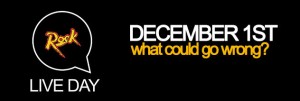 Today, of course, radio is at the far opposite end of the spectrum. Small studios sit completely vacant as automation systems play songs, voices are tracked, and production and commercials play in sequence, often without any need for human attention.
Today, of course, radio is at the far opposite end of the spectrum. Small studios sit completely vacant as automation systems play songs, voices are tracked, and production and commercials play in sequence, often without any need for human attention.
But for one day last month, the pendulum swung back the other way, and radio was once again 100% really and truly live – no tape, no digital production, no recordings. KISW’s “Live Day” featured live performers – musicians, announcers and, yes, even Foley artists. “Live Day” took place on KISW during the station’s personality-driven morning and afternoon teams executing every element of their shows completely live. It was the ultimate high wire-no net experiment, and a true innovation.
The concept of “Live Day” was spearheaded by VP/Programming and Operations for Entercom/Seattle Dave Richards, and it was a year in the making. So for this week’s edition of Radio’s Most Innovative we asked Dave to tell us about the experience: where the idea came from, the planning, execution, reaction, and the big question: Will it ever happen again?
JM: Explain the concept and execution behind “Live Day.”
DR: “Live Day” was a day on the BJ and Migs Show (6-10a) and The Mens Room (2-6pm) where each and every element was performed live. The content, commercials, songs, announcers, background music, and sound effects – absolutely everything performed live in real time.
JM: How long have you wanted to do this?
DR: I’ve had the idea in the back of my head for a long time, maybe 20 years, but it didn’t have much strategy or purpose. It was just an idea. KISW is an amazing team of creative performers and unique thinkers, and I knew they could pull it off.
JM: The “PPM Rules” would probably suggest KISW not do this. But you did it anyway.
DR: Best practices would say it’s a dumb idea. Sometimes it’s about building the brand, not living by the science.
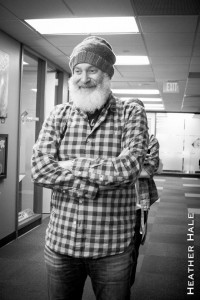
JM: How long did the planning process take?
DR: I’d say the discussions and planning started in earnest a little over a year ago. Six months before “Live Day,” we talked structure and resources, followed by three months of weekly meetings, and two weeks of stressing out. Those were the formal meetings, but the individual teams – morning and afternoon shows, the production team, music team, social media team, video team, promotion team – they were all working on their own channels.
JM: How many people were actually involved with putting this together and pulling it off?
DR: A core team of six people worked for a year, while another ten were involved the month leading up to it. On show day, there were about 65 people involved.
JM: What were the biggest obstacles to making it happen? How did you overcome them?
DR: You get swept up in “Oh, I got another idea.” In this process where you’re trying to go where no man has gone before, and there are so many creatives in the same room, you come up with a lot of ideas. The challenge was where to draw the line. There were quite a few things we either said “no” to or put on the back burner for next time.
Another challenge is that there wasn’t a blueprint. One station does a festival and you have a playbook. Not with this. I went to see (NPR’s) Wait Wait, Don’t Tell Me live. Brilliant show and great production, but they do it 52 weeks a year with the same team. This was a one time, first time, performance, with 35 musicians. We were taking on a mountain, not knowing how high it was and what gear to bring along.
Also the challenge of making sure the audience really understood what “Live Day” was all about. The pre-promotion was critical in bringing the audience into the concept.
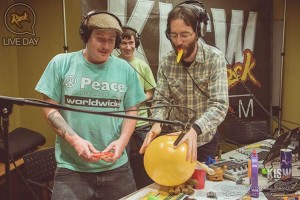
Then there were the Foley artists. Have you ever tried to find Foley artists? Not easy.
JM: What role did digital, mobile and social play in the broadcast?
DR: A big one with unprecedented results. From the start, we wanted the audience to live vicariously through the experience, so we took them behind the scenes a couple of weeks before “Live Day,” inside meetings, studios, and more with pictures and video. The setup and load in the day before and real time pictures and video the day of brought it to visual life.
It resulted in our single biggest day on social media and mobile app usage. And the feedback that all of us in radio live for: “I couldn’t get out of the car or office because I didn’t want to miss anything, so I listened on the app” was great. KISW Social Media Director Taryn Daly created the strategy, and the whole team contributed. Trending #1 on Twitter by 7am was nice, too.
JM: During the actual execution, what unexpected snags did you run into?
DR: Regularly scheduled bathroom breaks: not gonna happen. Smokers: not happy. And you’re doing live theater, and you don’t have experience doing live theater, so there are a few moments of “Oh shit.” And there were a couple of miscues, but those were part of the magic that made it real, made it human. We didn’t rehearse this, so it was to be expected.
Each team knew what they were doing: musicians know how to play their songs, announcers know how to read, the shows know how to do their thing, but weaving it all together was a different experience. Jason Dildine, our Production Director, took the chair like Francis Ford Coppola or Leonard Bernstein. He directed the producers, who directed the players, and it worked.
JM: What were some of the most memorable moments for you?
DR: There are a few segments and feature intros on BJ and Migs and The Mens Room that were very complicated: two music beds, three or
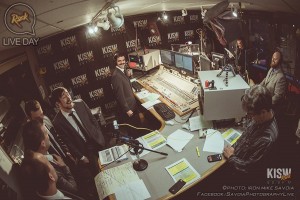
four announcers, and multiple sound effects. Watching that was wild. Having Seattle radio legend Bob Rivers voicing commercials and a live barbershop quartet as jingle singers were highlights.
Seeing the staff perform on a high wire, way out of their comfort zone was also very cool. It truly challenged everyone, but you knew if you fell, you’d only fall so far. Assistant Program Director Ryan Castle coordinated all the bands – and there were always two bands, one for the songs and another doing the background music for commercials and promos. Watching them go back and forth was pretty cool.
I’d say one thing that gave everyone chills was when the Doors tribute band, who are really great players, got together with the Foley artists and did “Riders on the Storm” with full rain and thunder accompaniment.
JM: What sort of reaction and feedback did you get from the audience?
DR: Overwhelmingly positive. Two weeks after and we were still hearing about it. And that’s the thing we didn’t know. There’s not a creative mind who doesn’t think their idea isn’t great. So you try something different like this and rather than get a bad reaction, you get no reaction.
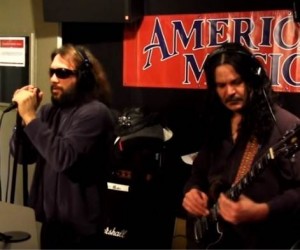
We prepared ourselves for that. But the results from social media alone, as well as the phone response, blew us away. And internally, we spent the day with full-on shit-eating grins.
JM: Looking back now, what would you do differently next time?
DR: Nothing really. We over-planned for this. I’m glad we said “no” to a few things, because it gave us the chance to evolve the concept and not take on additional craziness the first time out.
JM: And will there be a next time?
DR: Absolutely!
JM: Why do you think there isn’t more innovative, attention-getting programming on the air today?
DR: I don’t know. Fear and time management are all I can imagine. Every radio station, cluster, company has a different measure of success, so it’s not fair to judge. Maybe it’s not encouraged. Maybe it’s not needed.
In our case, when you are building a brand – which is what we all do – you have to try things. KISW is about to celebrate its 45th anniversary. It has a storied history of thinking left of center: a competitive hydroplane boat, “Nudestock,” a talent-based multi-match WrestleMania type event, a branded beer and vodka. It’s an expectation of the audience for us to do more than just play “Back in Black.”
JM: You work with other programmers in the building and in the company. What message are you sending with “Live Day?”
DR: “Live Day” was the right thing and a good thing for this brand. Maybe it’s the right thing for others, maybe not. Every station has a different strategy for success. They know the right thing for their audience. You pick your own poison.
But for KISW, we have to try things. It’s evolve or die. We’re always looking for creative new ways to connect with the audience and create revenue opportunities. We’re in the entertainment business. If we aren’t entertaining the audience, we aren’t doing our jobs.
Thanks to Mike Stern for writing this week’s edition of RMI.
To take a deeper dive into KISW’s innovative “Live Day,” here’s a compilation video that takes you behind the scenes:
https://youtu.be/ltis7x-ZQkY
Email recipients: click here to watch the KISW Live Day compilation video
INNOVATION QUOTE OF THE WEEK
“The only performance that makes it, that really makes it all the way, is the one that achieves madness.”
Mick Jagger
Check out some of our “Past Innovators” here:
- October 30 Zoo World
- November 13 Coca-Cola’s “First Taste Fridays”
- December 4 Greater Public’s Doug Eichten
- December 18 Liquidus
- What To Do If Your Radio Station Goes Through A Midlife Crisis - April 25, 2025
- A 2020 Lesson?It Could All Be Gone In A Flash - April 24, 2025
- How AI Can Give Radio Personalities More…PERSONALITY - April 23, 2025





The former morning show on Dublin’s 98FM did something similar…
https://www.98fm.com/The-Ray-Foley-Show-Naked-Breakfast-November-28th-2014
https://www.98fm.com/98FMs-Naked-Breakfast-2015
Eric, thanks for bringing this to our attention. I hope the fact that Ray’s no longer on 98FM isn’t a statement about how the “Naked Breakfast” concept played out. 🙂 I appreciate the comment, as I’m sure will Dave Richards.
When at WFBQ in Indy, we did a ‘Live Day’ just about every year.
It was always a work in progress and constantly adjusted to maximize the listener and client benefit. Eventually it evolved into two annual events:
‘Live Music Day’ as well as a ‘Live Commercial Day.’
Marty, thanks for checking in with this. It will be interesting to hear how KISW’s changes “Live Day” in year 2.
Love the KISW Live Day… complete with a banging cover of ACDC’s Highway To Hell 12 mins in. Yeah.
Hey, Darren – that station gets it.